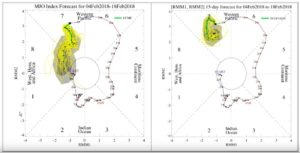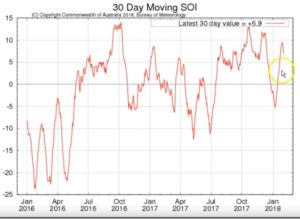There are two main lunar cycles. Moon’s elliptical orbit orientation rotates. This is called the Anomalistic month. One orbit of this shift in orientation takes 8.850578 years. The Draconic month is the orbit of the points of the lunar orbit where it crosses the Ecliptic Plane and an orbit takes 18.5996 years.
QBO or Quasi-biennial oscillation is variations of the stratospheric wind over the tropics. QBO variations follow a sinusoidal oscillation with a period of about 28 months. http://iopscience.iop.org/article/10.1088/1755-1315/149/1/012064/pdf
If you take the Draconic Month and divide this with 8 you get 2.325 year. If you calculate the QBO periodicity in years get 2.333 years. These two periods look very similar to me.
I follow a website or to be more correct YouTube videos from Stormsurf which are published weekly by a guy called Mark Sponsler. The first part of his videos are about weather and wave heights in the Pacific Ocean, dedicated to wave surfing, which is of no interest for me. The rest and the main parts of his videos is about MJO and ENSO which is what I’m interested in.
MJO or The Madden-Julian Oscillation is an oscillation which show the precipitation pattern in the tropics. The MJO data is important for weather predictions in the tropics and have impacts on ENSO. MJO is presented as a vector that moves counter clockwise along the equator. This rotation can vary between 30 to 60 days for its counter clockwise rotation. A few months ago, Mark Sponsler explained that the average rotation around the world is 41 days. After hearing that I took up my calculator. I added 2 average rotations which is 82 days. The time between Perigee’s is about 27.5 days. I took 82 and divided this with 27.5. The result was 2.98 which is very close to 3.
So, MJO follow multiples of Moon’s orbit and the Draconic month is 8 multiples of QBO. These correlations show that both QBO and MJO are dependent on Moon’s gravitational forcing.
I would also point out from a study over rainfall over Japan a cycle of 27 days which they link to the sun rotation. The sun’s rotation depends on the latitude on the sun and is not fixed. I think instead the likely cause is the gravitational tidal effect from the moon, 27.5 days.
https://www.sciencedaily.com/releases/2018/07/180717094705.htm
Here is a picture which show MJO daily representations with also includes two 2-weeks forecast in green. One based on a dynamic model and one based on a statistical model.
I’m building up a model where I hope to make longer, and more accurate forecasts models based on lunar and solar forcing. If I’ll succeed, only time will tell. I just finished with calculating key atmospheric tidal data. It has taken a long time.
Picture over SOI 30-day average.
SOI, Southern Oscillation Index, which is the value over pressure difference between Tahiti, in Polynesia and Darwin in Australia is affected by MJO. If MJO is positive over the Kelvin wave generation area east of New Guinea, a Kelvin Waves is generated, which is a pulse of warm water, that move warm water towards South America under the surface. Eventually, after about 3 months after this event, water if conditions are right, surface and may create or feed an El Niño. If you look at this picture above over SOI 30 days average, it is possible to see tagging like drops which is caused by positive SOI values moving over the Pacific. The time differences correspond to the time between 2 or 3 lunar orbits between lunar Perigee’s. Low frequency of SOI has the inverse of the El Niño/La Niña index.
Popular among climatologist and computer modeler is the idea of Chaos Theory. A butterfly flaps its wings and a few years later it’s the cause of a thunderstorm somewhere else in the world. This of course is bunkum, but only just. The real butterflies, much stronger ones, can be found lunar gravitational effects. Also, from the solar and magnetic impacts on the atmosphere. One error, apart from that they include too high climate sensitivity, in their climate models, are that build their models as black boxes where forces from outside are ignored or assumed to be stochastics. If they include lunar and solar forcing these models would perform much better. But, then, their CAGW theory would come crashing down.


